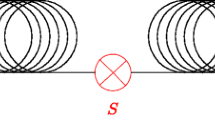Abstract
A finite relativistic quantum space-time is constructed. Its unit element is a spin pair with Palev statistics associated with an orthogonal group.
Access this chapter
Tax calculation will be finalised at checkout
Purchases are for personal use only
Similar content being viewed by others
References
Bopp, F., Haag, R.: Über die Möglichkeit von Spinmodellen. Zeitschrift für Naturforschung 5a, 644 (1950)
Dirac, P.A.M.: Spinors in Hilbert Space. Plenum, New York (1974)
Finkelstein, D.: Quantum Relativity. Springer, Heidelberg (1996)
Haldane, F.D.M.: “Fractional statistics” in arbitrary dimensions: A generalization of the Pauli principle. Phys. Rev. Lett. 67, 937 (1991)
Inönü, E., Wigner, E.P.: On the contraction of groups and their representations. Proc. Natl. Acad. Sci. 39, 510–525 (1952)
Palev, T.D.: Lie algebraical aspects of the quantum statistics. Unitary quantization (A-quantization). Joint Institute for Nuclear Research Preprint JINR E17-10550, Dubna (1977). hep-th/9705032
Palev, T.D., Van der Jeugt, J.: Jacobson generators, Fock representations and statistics of sl(n + 1). J. Math. Phys. 43, 3850–3873 (2002)
Penrose, R.: Angular momentum: An approach to combinatorial space-time. In: Bastin, T. (ed.) Quantum Theory and Beyond, pp. 151–180. Cambridge University Press, Cambridge (1971). Penrose kindly shared much of this seminal work with me ca. 1960
Saller, H.: Operational Quantum Theory I. Nonrelativistic Structures. Springer, New York (2006)
Schur, I.: Über die Darstellung der symmetrischen und der alternierenden Gruppe durch gebrochene lineare Substitutionen. Journal für die reine und angewandte Mathematik 139:155–250 (1911)
Segal, I.E.: A class of operator algebras which are determined by groups. Duke Math. J. 18, 221–265 (1951) Especially Sect. 6A
Unger, R.M.: The Self Awakened: Pragmatism Unbound. Harvard University Press, Cambridge (2007)
Yang, C.N.: On quantized space-time. Phys. Rev. 72, 874 (1947)
Acknowledgements
To Roger Penrose and Richard Feynman for kindly showing me their seminal spin quantizations of space and space-time before publication.
To O. B. Bassler, James Baugh, Walter L. Bloom, Jr., Dustin Burns, David Edwards, Shlomit Ritz Finkelstein, Andrei Galiautdinov, Dennis Marks, Zbigniew Oziewicz, Tchavdar Dimitrov Palev, Heinrich Saller, Stephen Selesnick, Abraham Sternlieb, Sarang Shah, and Frank (Tony) Smith, for helpful and enjoyable discussions.
To Lynn Margulis for introducing me to post-Darwinian symbiogenetic evolution in her Lindisfarne lectures.
To Cecylia Arszewski for leading me to Unger’s most helpful radical pragmatism.
To Prof. V. K. Dobrev for inviting me to this retreat of the Bulgarian Academy of Science.
Author information
Authors and Affiliations
Corresponding author
Editor information
Editors and Affiliations
Rights and permissions
Copyright information
© 2013 Springer Japan
About this paper
Cite this paper
Finkelstein, D.R. (2013). Palev Statistics and the Chronon. In: Dobrev, V. (eds) Lie Theory and Its Applications in Physics. Springer Proceedings in Mathematics & Statistics, vol 36. Springer, Tokyo. https://doi.org/10.1007/978-4-431-54270-4_3
Download citation
DOI: https://doi.org/10.1007/978-4-431-54270-4_3
Published:
Publisher Name: Springer, Tokyo
Print ISBN: 978-4-431-54269-8
Online ISBN: 978-4-431-54270-4
eBook Packages: Mathematics and StatisticsMathematics and Statistics (R0)



